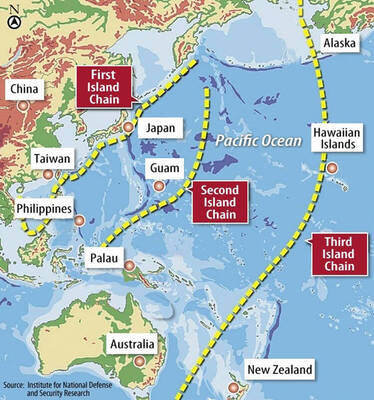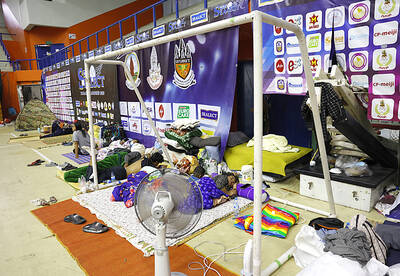Central China’s worst drought in more than 50 years is drying reservoirs and stalling rice planting, and threatens crippling power shortages as hydroelectric output slows, state media said yesterday.
Rainfall levels from January to last month in the drainage basin of the Yangtze, China’s longest and most economically important river, have been 40 percent lower than average levels of the past 50 years, the China Daily said.
The national flood and drought control authority has ordered the Three Gorges Dam, the world’s largest hydroelectric project, to increase its discharge of water by 10 percent to 20 percent for the next two weeks.
The measure is aimed at sending badly needed water to the Yangtze’s middle and lower reaches for drinking and irrigation.
Watermarks in more than 1,300 reservoirs in Hubei Province, where the dam is located, have dropped below allowable discharge levels for irrigation, the paper quoted Hubei Reservoir Management Director Yuan Junguang (袁俊光) as saying.
Rainfall in some areas is as much as 80 percent lower than usual, while the provinces of Anhui, Jiangsu, Hubei, Hunan, Jiangxi and Zhejiang along with Shanghai municipality are mired in their worst droughts since 1954.
“Without adequate water, we lost the spring planting season for rice,” Hubei farmer Zhou Xingtao was quoted as saying.
The paper said many other farmers in Hubei have lost their existing crops or given up on planting summer rice, fearing the emergency water supplies will be inadequate to sustain their fields, with more hot and dry weather forecast.
The agricultural impact is likely to further alarm officials already trying to tame high prices of key items such as food.
China — and the Yangtze river region in particular — is prone to the alternating threats of crippling drought followed by devastating flooding.
Just last summer, sustained torrential rainfall across the region caused widespread flooding and even some concern over whether the giant Three Gorges Dam would be able to contain the deluge.
More than 3,000 people were reported killed in the flooding and related landslides.
Nearly every year, some part of China suffers its worst drought in decades, and meteorological officials have said previously the extreme weather may be because of climate change.
The State Grid, China’s state-owned power distributor, reportedly said this week that 10 of its provincial-level power grids were suffering severe shortages because of the drought’s impact on hydroelectric generation, including grids in Shanghai and the heavily populated southwestern Chongqing region.
China could face a summer electricity shortage of 30 gigawatts — the most severe power shortfall since 2004, the company said.
The drought is also posing a threat to the Yangtze basin’s highly endangered population of freshwater dolphins, as water levels have plunged as much as 3m in key dolphin areas, raising the risk of stranding the animals.
There are an estimated 1,000 of the dolphins — fewer than the giant panda — and that number is falling because of pollution and other environmental woes.

The US government has signed defense cooperation agreements with Japan and the Philippines to boost the deterrence capabilities of countries in the first island chain, a report by the National Security Bureau (NSB) showed. The main countries on the first island chain include the two nations and Taiwan. The bureau is to present the report at a meeting of the legislature’s Foreign Affairs and National Defense Committee tomorrow. The US military has deployed Typhon missile systems to Japan’s Yamaguchi Prefecture and Zambales province in the Philippines during their joint military exercises. It has also installed NMESIS anti-ship systems in Japan’s Okinawa

‘WIN-WIN’: The Philippines, and central and eastern European countries are important potential drone cooperation partners, Minister of Foreign Affairs Lin Chia-lung said Minister of Foreign Affairs Lin Chia-lung (林佳龍) in an interview published yesterday confirmed that there are joint ventures between Taiwan and Poland in the drone industry. Lin made the remark in an exclusive interview with the Chinese-language Liberty Times (the Taipei Times’ sister paper). The government-backed Taiwan Excellence Drone International Business Opportunities Alliance and the Polish Chamber of Unmanned Systems on Wednesday last week signed a memorandum of understanding in Poland to develop a “non-China” supply chain for drones and work together on key technologies. Asked if Taiwan prioritized Poland among central and eastern European countries in drone collaboration, Lin

The Chien Feng IV (勁蜂, Mighty Hornet) loitering munition is on track to enter flight tests next month in connection with potential adoption by Taiwanese and US armed forces, a government source said yesterday. The kamikaze drone, which boasts a range of 1,000km, debuted at the Taipei Aerospace and Defense Technology Exhibition in September, the official said on condition of anonymity. The Chungshan Institute of Science and Technology and US-based Kratos Defense jointly developed the platform by leveraging the engine and airframe of the latter’s MQM-178 Firejet target drone, they said. The uncrewed aerial vehicle is designed to utilize an artificial intelligence computer

Renewed border fighting between Thailand and Cambodia showed no signs of abating yesterday, leaving hundreds of thousands of displaced people in both countries living in strained conditions as more flooded into temporary shelters. Reporters on the Thai side of the border heard sounds of outgoing, indirect fire yesterday. About 400,000 people have been evacuated from affected areas in Thailand and about 700 schools closed while fighting was ongoing in four border provinces, said Thai Rear Admiral Surasant Kongsiri, a spokesman for the military. Cambodia evacuated more than 127,000 villagers and closed hundreds of schools, the Thai Ministry of Defense said. Thailand’s military announced that